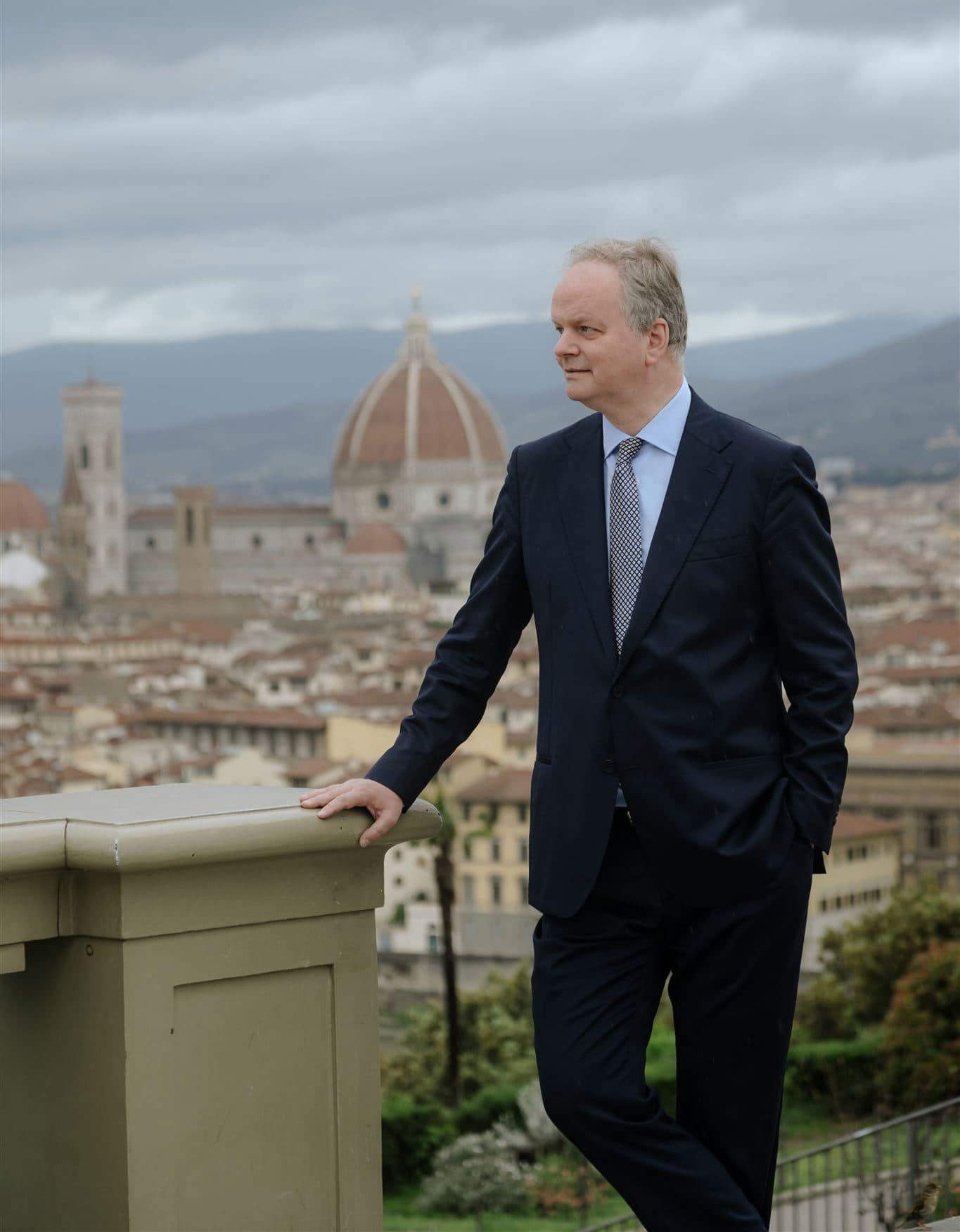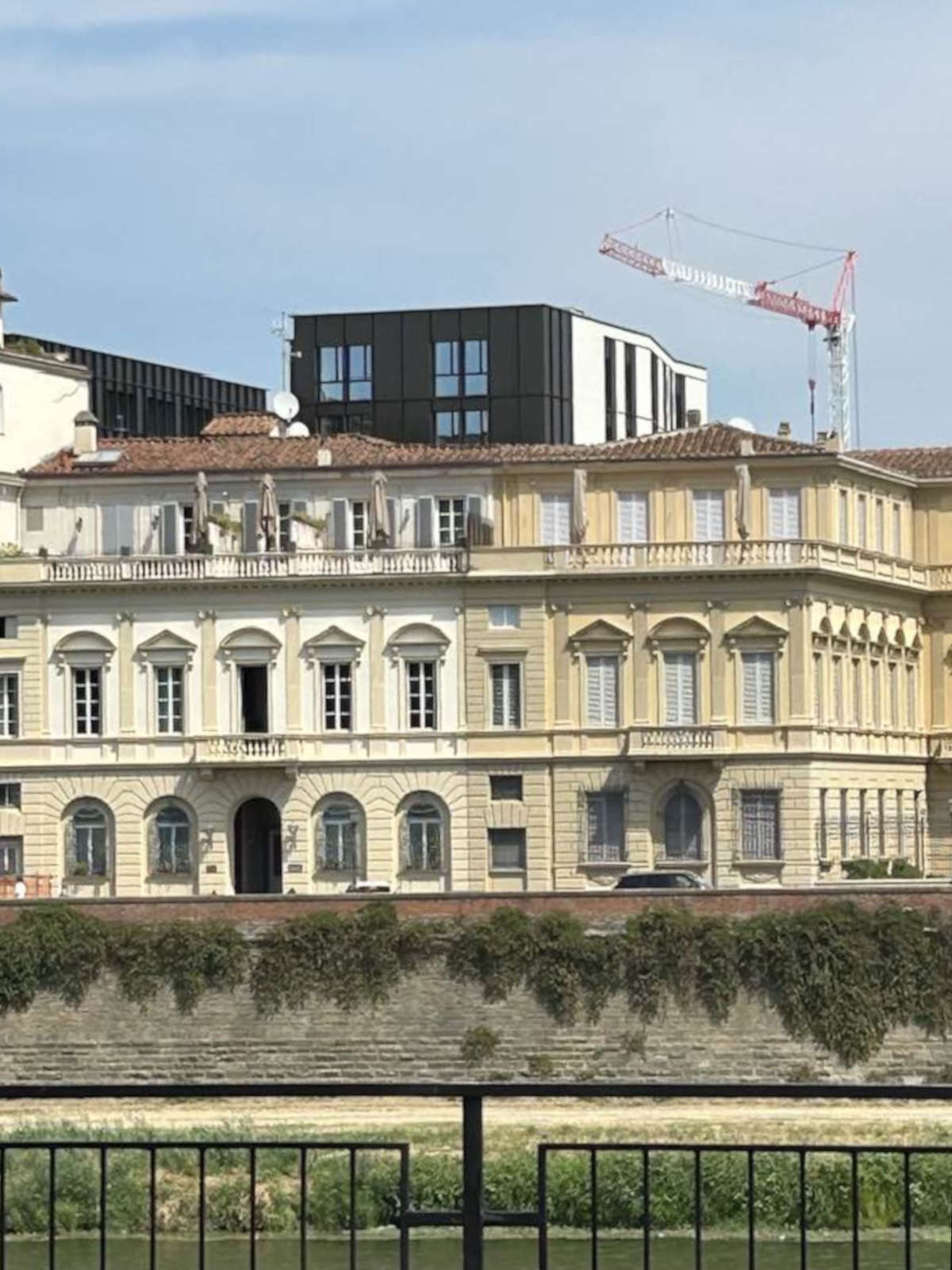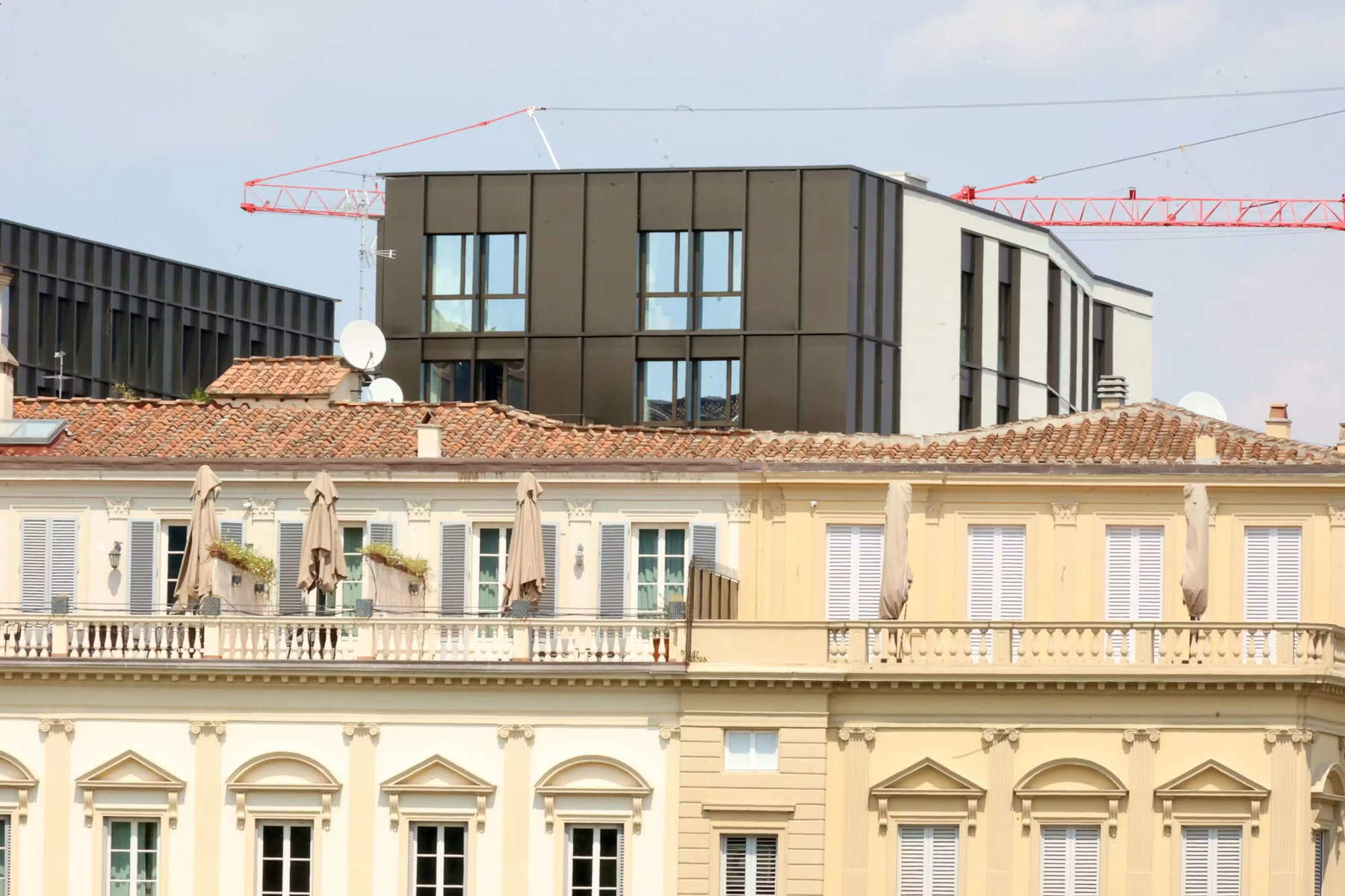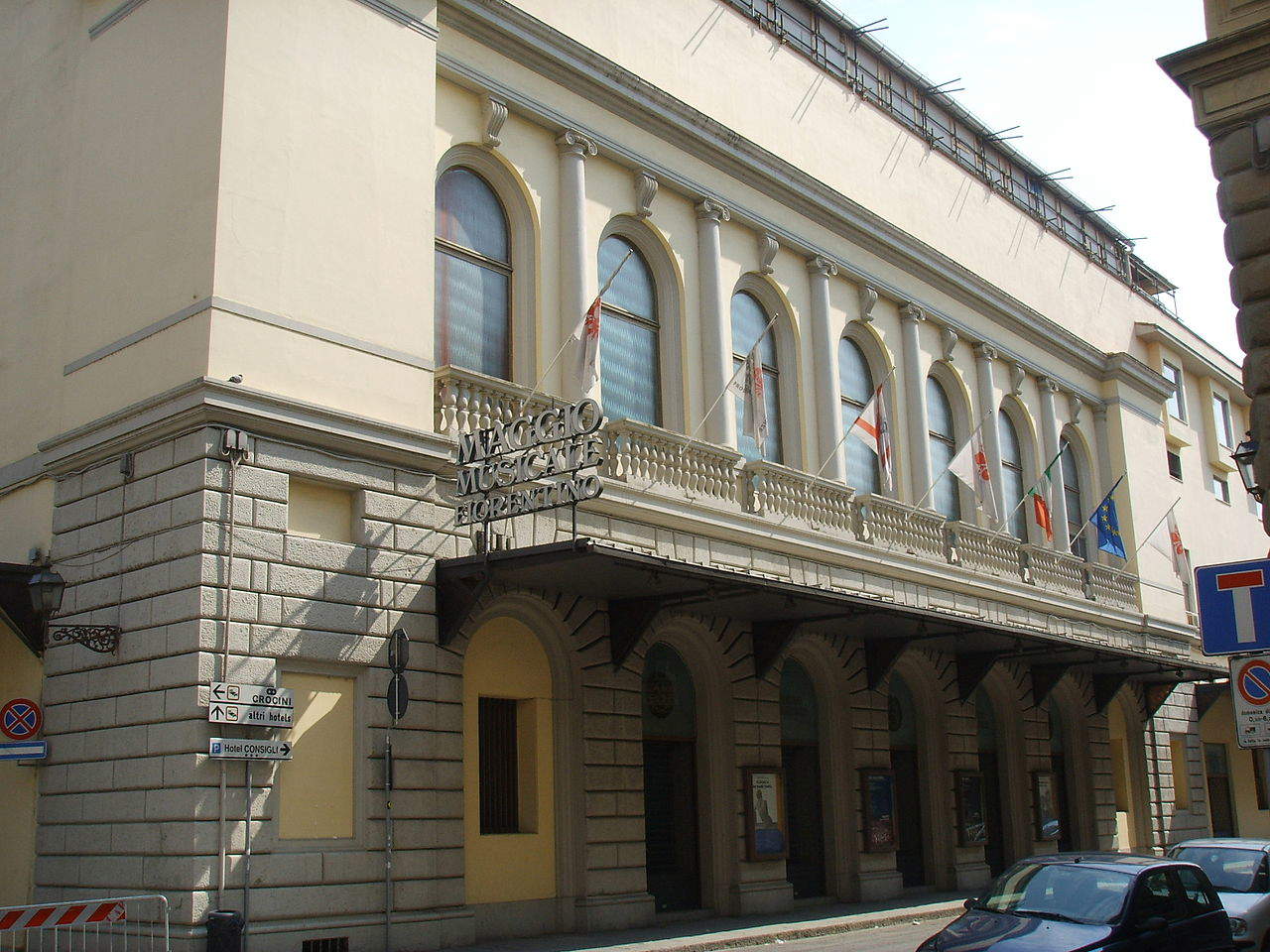It is the case that has stirred up discussion throughout Florence and beyond: the building that has taken the place of the former Municipal Theater, for which there has been an almost unanimous outcry because of the profile that greatly impacts the nineteenth-century buildings of the Lungarno Vespucci, beyond which can be seen the mass of what Florentines have already dubbed the “black cube” because of its shapes that are not exactly in keeping with its surroundings. Among the first to raise the case is the former director of the Uffizi (and now director of the Capodimonte Museum and Real Bosco in Naples), Eike Schmidt, a candidate for mayor for the center-right in the last municipal elections. We caught up with him to get his point of view: according to Schmidt, the “black cube” is not just a “ruin,” as he calls it, but a symptom of something more serious that forces us to reflect on many issues. Schmidt’s fears are diverse: from the loss of Unesco heritage status to the marginalization of citizens, from the selling off of the city to the endangered future of the Santo Spirito Convent. The interview is by Federico Giannini.

FG: Director, you were among the first to denounce the black cube affair in Florence. And already ten days ago you were saying that you would consider filing a complaint with Unesco. Have you already sent it? Or are you preparing it?
ES.: The first to report the case was Massimo Sabatini of my civic list, on May 6, 2025. At that time, however, he was not heard by anyone, nor taken up by the press, and only when the cube was unveiled (and not with a ceremony, but when the protective tarpaulins of the construction site were removed and everyone could see it), then I think I was the first, or among the first, to stigmatize this havoc. I immediately thought of a possible complaint to Unesco, because it seems clear that the usual thresholds and procedures of protection have somehow failed. In fact, Dresden and Liverpool were even stripped of their World Heritage status by Unesco, again on the basis of a new building or bridge. As always, for an exposé you don’t need opinions or conclusions, but factual elements to evaluate. So we are putting together objective elements to be forwarded to UNESCO. Our goal, of course, is not to have Florence removed from the Unesco sites, but rather the opposite: to ensure Florence’s permanence, perhaps with prescriptions on changes to the offending building, perhaps another formal “yellow card,” which Florence moreover has already suffered a decade ago.
In your opinion, concretely, does Florence really risk losing its Unesco heritage status because of this affair?
The risk is there. We need to prepare to act accordingly and evaluate whether, for example, lowering the building would bring it within the parameters. The underlying problem, that is, the lack of a vision for Florentine building and the social function of the city is not solved in this way, and the building would remain what it is, but it might be a small step to at least include it more congruently in the Florentine historic landscape. These are some hypotheses that are on the horizon.


In your opinion, how is it possible that a project that was started more than 15 years ago raises so much outrage only now, when construction is almost finished?
The answer is very simple: because only now does everyone see plastically before their eyes the result of a concatenation of decisions and choices made by various institutions and different bodies, but above all by the City of Florence. The individual steps that led to this result were not always made known, but were closed in the relevant committees. There was certainly some protest when the decision was made to abandon the historic Teatro dell’Opera, a place of historic opera sets and productions, of glorious moments of the Maggio Musicale, and which by the way was also a symbol of victory after World War II: it was one of the few places in Florence where a Nazi bomb fell, while the bridges of Florence were destroyed with explosives on the ground. Therefore, the inauguration in 1961 of the building, which was returned to the citizenry, was a moment of relief and glory after all the suffering of the war and the hardships of the immediate postwar period. With its destruction, practically razing it to the ground except for a part of the facade, this value is already lost: practically we no longer have a material memory, we are left with only the intangible one of this very symbolic cultural history for Florence. It is certainly not possible to have all projects evaluated by all citizens, but this was one of the most important and most impactful, and it deserved to be presented and discussed publicly. But from this horrible experience we must also learn lessons for the future, because the black-and-white cube is just the poisoned icing on a cake that is no less poisoned, since it is part of a whole series of alienations of the common heritage: very important historic buildings that the City of Florence has sold (to be euphemistic), or rather sold off, in recent decades. In not a single case have we really seen a redevelopment of the city, as has always been promised, nor a social use of the so-called redevelopments. We should take the black-and-white parallelepiped as the highest possible alarm. We need to wake up! By the way, the next project is ready and everyone knows it: it is the convent of Santo Spirito destined to once again house a luxury RSA, and this time inside an absolute masterpiece of the Renaissance, which is being turned upside down for the purpose. Sixteenth-century spaces will be lofted, walls will be built in front of the frescoes. The original sin of the structure was the administrative division between the army, the municipality and the convent, which occurred during the period of Italian Unification. But the physical division and functional abuse that is about to occur will be a real violence against a Renaissance masterpiece. The intended use is a matter solely for the municipality, which with a stroke of a pen could stop this havoc, but it does not, and one has to seriously wonder why, what lies beneath. Citizens, politicians, Florentines and outsiders must be activated to save Santo Spirito, its fragmented administrative reality must be recompacted and its architecture (the original design is by Ammannati, other parts are by Parigi: we are in front of one of the highest examples of Renaissance and Counter-Reformation architecture) must be enhanced. This very important Augustinian monastery was an intellectual center of world importance in the Renaissance, which is why its protection is also of national and international significance.
To citizens and politicians I would also add intellectuals. And in this regard: how do you assess the attitude of the Florentine intellectual class, which in the past has always seemed to be very present, on issues that have also concerned you closely (I remember, for example, the controversy over the nationality of state museum directors, or the Ferragni affair at the Uffizi, when you spoke of “puzzalnasists”)...
Meanwhile, I do not see a single class of intellectuals in Florence, but different groupings. Against foreign directors, apart from a few ill-informed xenophobes, I have not heard any intellectual voices of protest. If you are referring to those who ranted about Ferragni’s presence at the Uffizi in the pandemic years, about a paid service for our benefit that also involved young people, at that time it made sense and worked great: those criticisms were sterile and led to nothing. However, it doesn’t take a doctorate to understand immediately that the so-called black-and-white cube clashes with the architecture around it. Everyone says that, and with complete reason. It is not even a matter of contrasting political orientations-no point in making it a symbol of the battle between left and right, because we all lose our way here. Nor is it a question of taste. In Renaissance terms, here it is not just about pulchrum but aboutaptum, that is, a category that is itself necessarily interpersonal and social, one might say identitary for a community, and not reducible to subjective perception.
To stay on the topic: all those among the Florentine intellectuals who would have the ability to take accurate x-rays of what is happening and, to some extent, even the ability to guide public opinion (we have seen this so many times), in your opinion have they done enough? Have they been sufficiently vocal? Has the voice been stentorian enough, or could something more have been done and better followed up to avoid getting where we have gotten?
I have not heard all these voices over the years, apart from the protests at the dawn of the (at the time still abstract) decision to replace the Maggio Musicale Theater. And there couldn’t have been, because as mentioned, the various authorization steps took place within the various technical offices. This is also why the mayor’s role is conceived as an interpreter of the citizenry he represents. We need to see if the mayor was not up to the task, we need to see if the supervisory bodies did their job properly, but we also need to look from a structural point of view at what other stakes need to be put in place to reduce the risk of ending up like this again. It will certainly take more transparency, but it will also take a change in the policy of the municipality, which must put citizens at the center and not revenue collection. Unfortunately, the parallelepiped is not the first case but is part of a series of alienations of public buildings that had played a role in the life of the city in the past.

At the opposite pole, there are also those who believe that the modernization of Florence may well be worth a cube rising behind the nineteenth-century buildings of the Vespucci Arno Riverfront and who tend to dismiss criticism, deeming it to be polemical passé. In short, some see the operation as welcome. Must Florence then be a city destined for perpetual preservation, or can it have a present and a future that coexist without pummeling each other? Simply put: can there be (as in Paris, for example) a contemporary architecture that insists on the historic center of Florence? Or must there be an inviolable and impassable limit in Florence, and if so what should it be?
I have not heard a single serious voice in favor of this latest disfigurement. However, the superimposition of the modern on the ancient, when it makes sense, should not be condemned. The Santa Maria Novella station is in the architectural textbooks, and Michelucci built it precisely so that it would fit perfectly into the historic fabric of the city. This unfortunately cannot be said of the forest of tramway poles in what is now Station Square. And especially not of the black-and-white cube that could house any office or hotel anywhere in the world. It does not react in any way to the history and architectural culture of the place. It is banal architecture. What’s more, it should be pointed out that in contemporary architecture the virtuous rule of fitting into the existing reality not only in an ideal way but also in a material way, using local or at least regional raw materials, or even developing existing buildings creatively instead of razing them to the ground and building new ones, prevails more and more. A much more ecologically sustainable approach, but also economically. Pritzker Prize winners are increasingly architects who follow these principles. Think of Diébédo Francis Kéré, Anne Lacaton, and Jean-Philippe Vassal, but many ideas can already be found decades ago in the work and theoretical writings of Yona Friedman, who died aged 97 in 2020.
To close: how do you think this story will end? And what lessons can be learned from it?
In this specific case, we need to arrive at a solution that at least restores dignity to this historic place. But as far as Florence is concerned, we need to stop selling the few public buildings that are left to make additional luxury residences. They were not even sold “to the highest bidder”: instead, I would say to the one among the indecent bidders who put in an extra lira. On the contrary, we need to have a vision for the city that meets the needs of Florentines now. We need to think about the livability of the city of Florence and what kind of contemporary interventions should be made, for what use, to make it a city for the citizens again. Because now it is not. But in the immediate term, the biggest problem apart from the black-and-white cube is the convent of Santo Spirito, which must be defended, saved and enhanced with all our might.
Warning: the translation into English of the original Italian article was created using automatic tools. We undertake to review all articles, but we do not guarantee the total absence of inaccuracies in the translation due to the program. You can find the original by clicking on the ITA button. If you find any mistake,please contact us.